NESRGB version 4
Version 4 of the NESRGB is pin and feature compatible with previous versions. This document describes the additional features and provides installation instructions while the new guides are being made.
There are six different colour palettes built in. The palette can be chosen via mechanical switch, like in versions 1 and 2 (both three and four position switches will work), or via the controller. The in-game reset feature is activated with a controller button combination.The available palettes are,
- Digital Prime (from FirebrandX)
- Nestopia_YUV - Looks most like a PAL console.
- Sony CXA - Very colourful palette of unknown origin.
- Smooth V2 (from FirebrandX) - Lower colour saturation.
- FCEUX - Another colourful palette, taken from the FCEUX emulator.
- Wavebeam
If the NESRGB is set to use the controller for palette selection, the button combinations are,
- Start+Select+Left - Decrement palette counter.
- Start+Select+Right - Increment palette counter.
- Start+Select+Left (hold for 2 seconds) - Disable/enable NESRGB board.
- Start+Select+Right (hold for 2 seconds) - Set to palette 1.
- Start+Select+A+B - In game reset.
- J1 is palette selection mode. Open = mechanical switch selects palette, closed = controller selects palette.
- J2 selects which palettes are used in mechanical switch mode. Open = palettes 1-3, closed = palettes 4-6. This is only used when J1 is open.
- J6 is reset polarity. Open = negative (Famicom, NES top loader), closed = positive (NES front loader).
- J10 is for de-jitter timing correction. Open = standard timing, closed = de-jitter active (recommended). Affects NTSC consoles only.
- J11 is a way to disable the indicator LEDs on the NESRGB board. Open = LEDs active, closed = LEDs all disabled.
The palette selection pins are labelled as follows
- RO - Reset switch output.
- 1D - Palette 1/controller data pin.
- 2C - Palette 2/controller clock pin.
- 3L - Palette 3/controller latch pin.
- GND - Ground pad for convenience.
In mechanical switch mode (J1 open) functions exactly like NESRGB version 1/2. Connect the palette 1, 2 or 3 pad to ground with a switch to select the palette and enable the NESRGB board. The RO pad is unused in this mode.
In controller mode (J1 closed) the data/clock/latch must be wired to player 1 controller port. The RO should be wired to the reset switch if the in-game reset feature is to be used. The ground pad is unused in this mode. Read the console specific parts below for installation details.
The design of NESRGB version 4, which uses a RAM based FPGA and a helper microcontroller to read the controls, requires a bit of extra time to start up when the console is switched on. The power on reset delay of the front loading NES is too short so its timing capacitor must be changed to accommodate this. Start up delay on the Famicom consoles is normally fine as it is, but a replacement timing capacitor is included with the kit just in case it has failed. The NESRGB can detect if the timing delay is incorrect and will blink LED 7 at power up if this is the case. A fast blink means the timing capacitor must be replaced. A slow blink means it is marginal.
NES front loader installation details
Player 1 controller port connection is labelled P4 I. The pin list is,
- Ground - brown wire.
- Clock - red wire.
- Latch - orange wire.
- Data - yellow wire.
- +5V - white wire.
- ? - blue wire.
- ? - purple wire.
The power/reset switch assembly connection is labelled P6, is large and blue. Pin list
- Unregulated power input to power switch - brow wire.
- Unregulated power from switch to the voltage regulator - red wire.
- +5V - orange wire.
- Reset signal - yellow wire.
- Power LED - white wire.
The reset signal is also connected to pin 7 of the CIC chip which is the 16 pin chip with the 'CIC' marked on the board next to it. The reset timing capacitor (C8 on my NES motherboard, may be different on others) is also connected to the reset signal. It is a 100n ceramic capacitor. It must be replaced with the 220n capacitor (marked 224) supplied in the NESRGB kit. In the photo below it has already been replaced.
To use the controller to select the palette solder jumpers J1 and J6 must be closed on the NESRGB board.
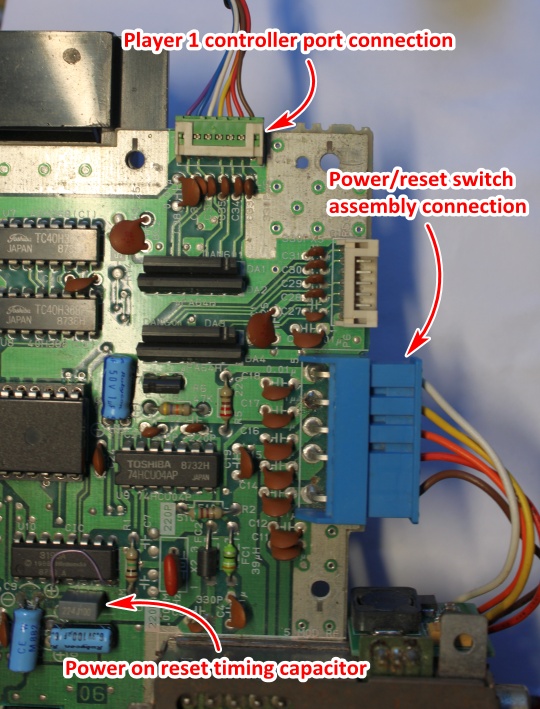
AV Famicom installation details
Player 1 controller port pin list.
- Ground
- Clock
- Latch
- Data
- +5V
- ?
- ?
To use the controller to select the palette solder jumper J1 must be closed on the NESRGB board.
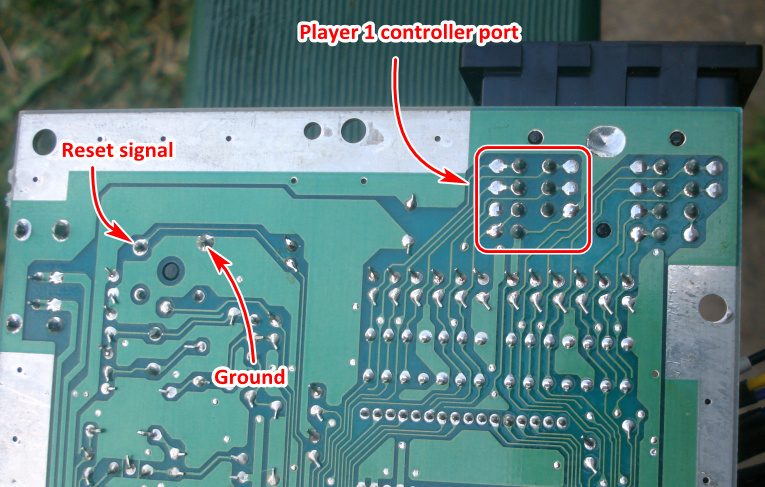
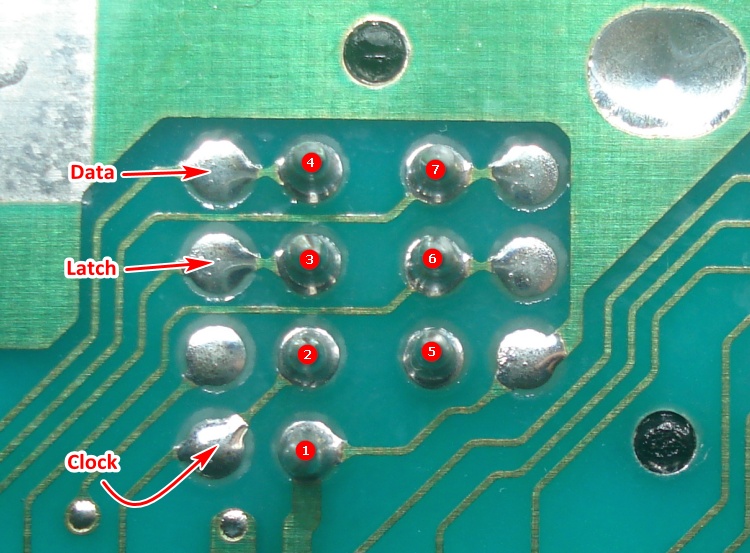
Original Famicom installation details
Player 1 controller port connection is labelled I.
The pin list is,
- Ground - brown wire.
- Data - red wire.
- Latch - orange wire.
- Clock - yellow wire.
- +5V - green wire.
To use the controller to select the palette solder jumper J1 must be closed on the NESRGB board.
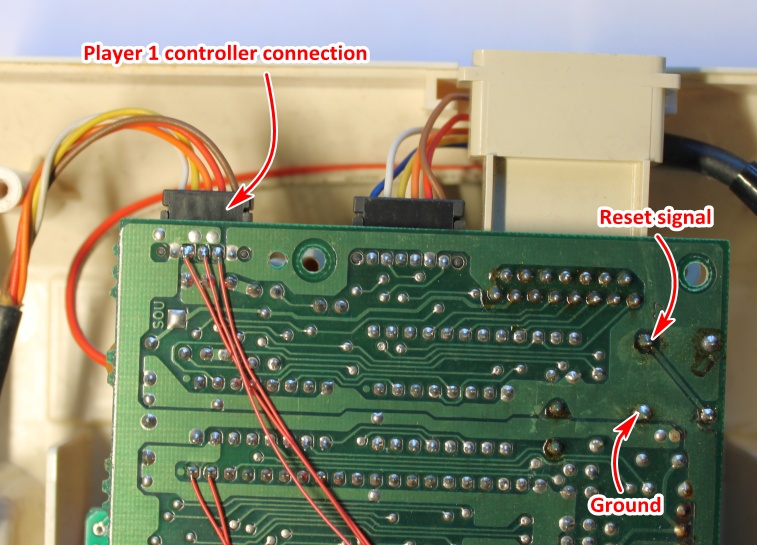
Famicom Twin installation details
Player 1 controller port connection is labelled A.
The pin list is,
- Ground - brown wire.
- Data - red wire.
- Latch - orange wire.
- Clock - yellow wire.
- +5V - green wire.
To use the controller to select the palette solder jumper J1 must be closed on the NESRGB board.

Here is the location of the reset signal.
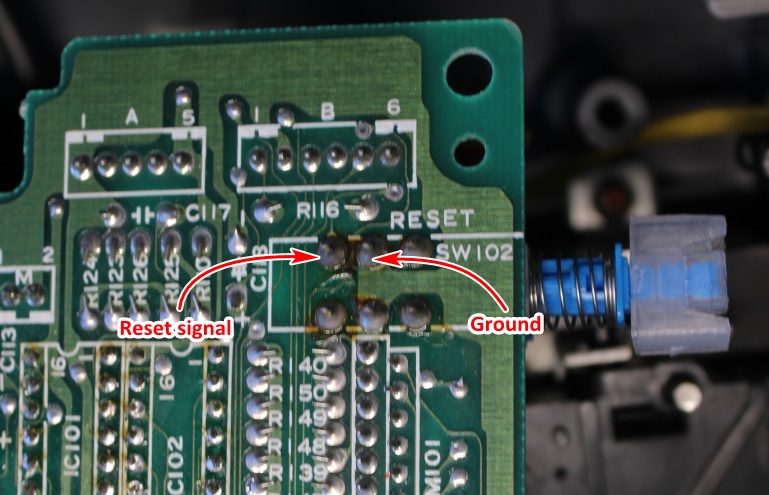
Created 24/8/2022.
Updated 26/9/2022.